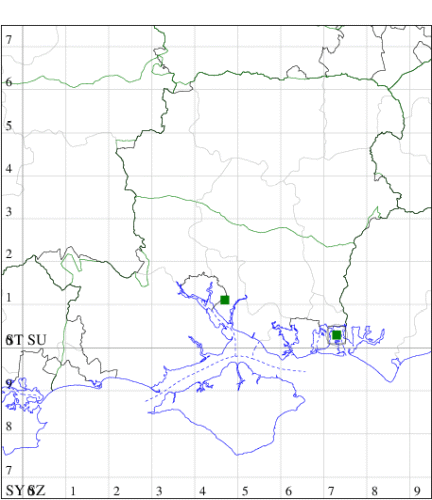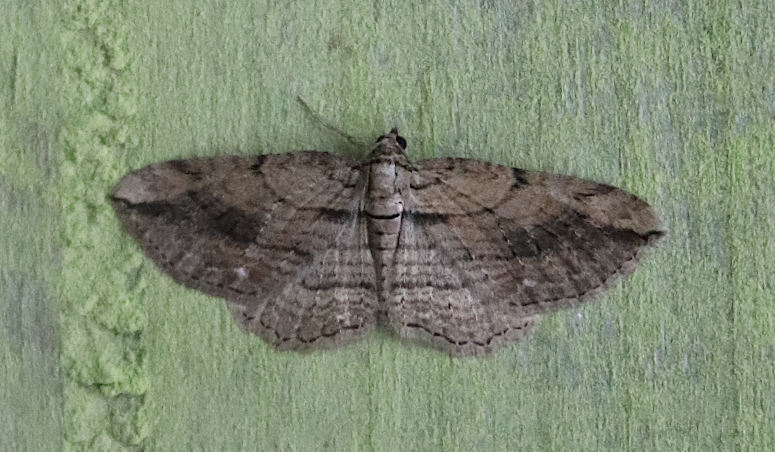Cryptic Fern
Horisme radicaria
Checklist Number70.1271 [B&F: N/A]
Verification
Record requires retention of specimen until confirmed, and may require dissection. Consult with CMR if unsure
Classification
| Family: | Geometridae |
| Subfamily: | Larentiinae |
| Genus: | Horisme |
| Species: | radicaria |
| Authority: | (La Harpe, 1855) |
Very closely related to the more common and widespread Fern H. tersata, H. radicaria was added to the British list from a specimen taken in East Sussex on 22 May 2019, and a number more from East Sussex and Kent in 2020 indicate that it is now resident locally in those two counties; retrospective records from East Sussex in 1990 and Kent in 2004 and 2007 make it probable that it has been present for a number of years. The species does appear to have experienced a north and westward range expansion on the near continent, so its arrival may be relatively recent. The first for our area were recorded on Hayling Island in 2020, since which it has been recorded increasingly frequently. See Clancy and Smith in Atropos: 66 for more details.
Adults should be photographed and retained for dissection, as distinguishing features between radicaria and tersata are subtle, especially if the moth is worn. The above quoted article has full details, but in summary radicaria has a longer, more defined apical streak, stronger cross-lines and darker forewing tone. Like its congener, the larval foodplant is Traveller's-joy Clematis vitalba. Both species are double-brooded in Britain, found between May and early September.
Adults should be photographed and retained for dissection, as distinguishing features between radicaria and tersata are subtle, especially if the moth is worn. The above quoted article has full details, but in summary radicaria has a longer, more defined apical streak, stronger cross-lines and darker forewing tone. Like its congener, the larval foodplant is Traveller's-joy Clematis vitalba. Both species are double-brooded in Britain, found between May and early September.


The abundance in each month is indicated as follows:
 No records
No records Very occasional
Very occasional Irregular
Irregular Uncommon
Uncommon Off-peak, but not unusual
Off-peak, but not unusual Off-peak, but not unusual
Off-peak, but not unusual Main flight time
Main flight time| J | F | M | A | M | J | J | A | S | O | N | D | |
|---|---|---|---|---|---|---|---|---|---|---|---|---|
| Adult |  |  |  |  |  |  |  |  |  |  |  |  |
| Larval |  |  |  |  |  |  |  |  |  |  |  |  |
Records by week (adult)
Records by week (larval)
VC11 South Hampshire
| Site | Date | Quantity | Recorder | Stage |
|---|---|---|---|---|
| Northney, Hayling Island (SU70) | 08/08/2020 | one | John W Phillips | Adult |
| Northney, Hayling Island (SU70) | 11/08/2020 | one | John W Phillips | Adult |
| Sholing, Southampton (SU41) | 05/09/2021 | one | Andrew Collins | Adult |
| Portchester Castle (SU60) | 06/05/2023 | one | Keith Wheeler | Adult |
| Portchester (SU60) | 06/05/2023 | one | Clare Harrison & Jon Stead | Adult |
| Portchester (SU60) | 08/05/2023 | one | Keith Wheeler | Adult |
| Blackfield (SU40) | 17/05/2023 | one | Steven J Jackson | Adult |
| Portchester (SU60) | 23/05/2023 | one | Clare Harrison & Jon Stead | Adult |
| Portchester Castle (SU60) | 23/05/2023 | one | Keith Wheeler | Adult |
| Fareham (SU50) | 10/08/2023 | one | Keith Wheeler | Adult |
| Fareham (SU50) | 17/08/2023 | one | Keith Wheeler | Adult |
VC12 North Hampshire
| Site | Date | Quantity | Recorder | Stage |
|---|---|---|---|---|
| Noar Hill HIWWT NR, Selborne (SU73) | 01/09/2023 | one | Tony Davis, Fi Haynes | Adult |



